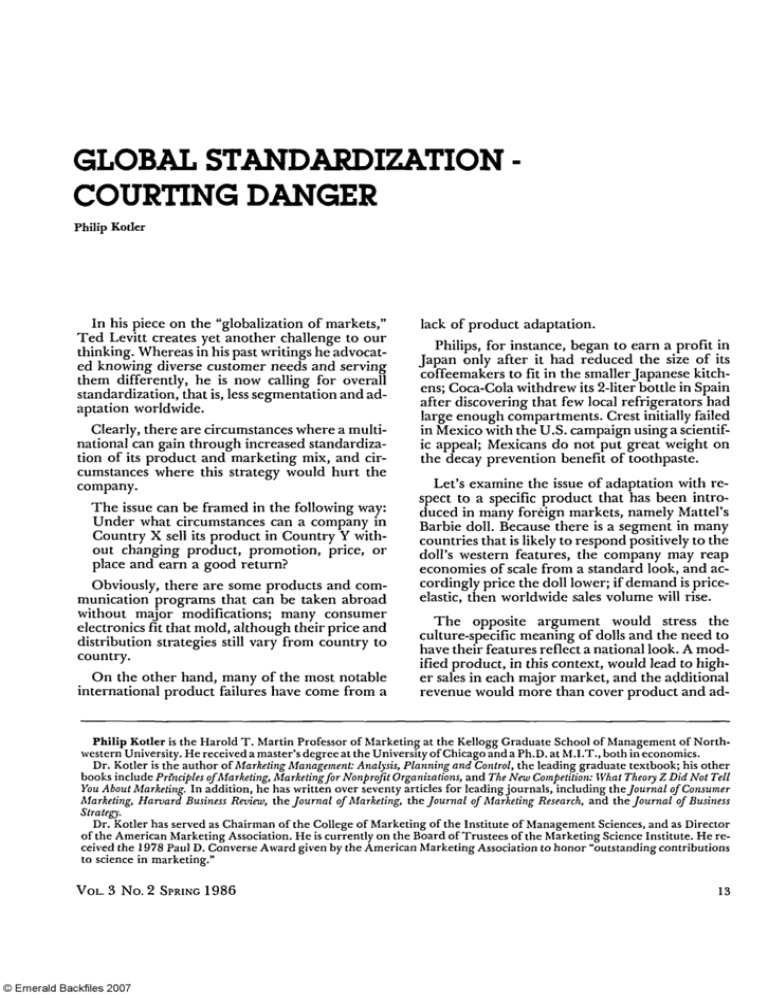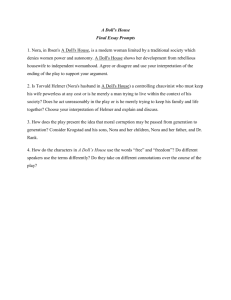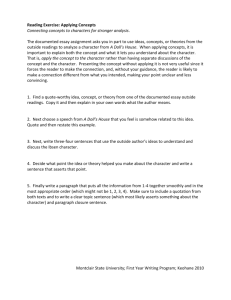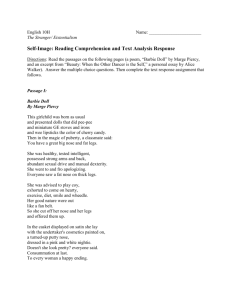Global Standardization - Courting Danger
advertisement

GLOBAL STANDARDIZATION COURTING DANGER Philip Kotler In his piece on the "globalization of markets," Ted Levitt creates yet another challenge to our thinking. Whereas in his past writings he advocated knowing diverse customer needs and serving them differently, he is now calling for overall standardization, that is, less segmentation and adaptation worldwide. Clearly, there are circumstances where a multinational can gain through increased standardization of its product and marketing mix, and circumstances where this strategy would hurt the company. T h e issue can be framed in the following way: Under what circumstances can a company in Country X sell its product in Country Y without changing product, promotion, price, or place and earn a good return? Obviously, there are some products and communication programs that can be taken abroad without major modifications; many consumer electronics fit that mold, although their price and distribution strategies still vary from country to country. On the other hand, many of the most notable international product failures have come from a lack of product adaptation. Philips, for instance, began to earn a profit in Japan only after it had reduced the size of its coffeemakers to fit in the smaller Japanese kitchens; Coca-Cola withdrew its 2-liter bottle in Spain after discovering that few local refrigerators had large enough compartments. Crest initially failed in Mexico with the U.S. campaign using a scientific appeal; Mexicans do not put great weight on the decay prevention benefit of toothpaste. Let's examine the issue of adaptation with respect to a specific product that has been introduced in many foreign markets, namely Mattel's Barbie doll. Because there is a segment in many countries that is likely to respond positively to the doll's western features, the company may reap economies of scale from a standard look, and accordingly price the doll lower; if demand is priceelastic, then worldwide sales volume will rise. T h e opposite argument would stress the culture-specific meaning of dolls and the need to have their features reflect a national look. A modified product, in this context, would lead to higher sales in each major market, and the additional revenue would more than cover product and ad- Philip Kotler is the Harold T. Martin Professor of Marketing at the Kellogg Graduate School of Management of Northwestern University. He received a master's degree at the University of Chicago and a Ph.D. at M.I.T., both in economics. Dr. Kotler is the author of Marketing Management: Analysis, Planning and Control, the leading graduate textbook; his other books include Principles ofMarketing, Marketingfor Nonprofit Organizations, and The New Competition: What Theory Z Did Not Tell You About Marketing. In addition, he has written over seventy articles for leading journals, including the Journal of Consumer Marketing, Harvard Business Review, the Journal of Marketing, the Journal of Marketing Research, and the Journal of Business Strategy. Dr. Kotler has served as Chairman of the College of Marketing of the Institute of Management Sciences, and as Director of the American Marketing Association. He is currently on the Board of Trustees of the Marketing Science Institute. He received the 1978 Paul D. Converse Award given by the American Marketing Association to honor "outstanding contributions to science in marketing." VOL. 3 NO. 2 SPRING 1986 13 THE JOURNAL OF CONSUMER MARKETING vertising modification costs. In fact, in the two years after Mattel allowed its Japanese affiliate to "Japanize" Barbie Doll's features, sales blossomed from near zero to 2 million. Interestingly, Barbie sold well without modification in 60 other countries. Does this mean that Mattel was smart in not modifying the doll in these countries? Or does this suggest that Mattel would have done much better to modify the doll in most markets, based on the Japanese experience? T h e issue can now be restated: In designing a new product, should a U.S. manufacturer design a single U.S. version, a single global version, or several global versions of the new product? Thus, Mattel had three design alternatives when it created the original Barbie Doll: There are three possible positions on this issue: 1. Design for U.S. market only 2. Design one product and marketing program for the global marketplace 3. Design national or regional adaptations in advance T h e first position is obviously myopic, or dis- 14 tressingly chauvinistic, given the worldwide marketing opportunities that abound. T h e second position entails searching for the one set of product and marketing features that would work best worldwide, including naming, packaging, and so forth. I happen to be in favor of the third position. First, most exported products need and receive some adaptation. One study found that 80 percent of U.S. exports required one or more adaptations. Furthermore, the average product requires only four to five adaptations out of a set of eleven marketing elements: labeling, packaging, materials, colors, name, product features, advertising themes, media, and execution, price, and sales promotion. I believe that all eleven elements must be checked in planning any export. If no changes are found to be needed, then we arrive at the second position mentioned above-but not through simply assuming that we can get away with standardization. Table 1 summarizes the global decision process. Design II applies to a product that can be exported under a universal name and form as a "world doll" or a "world car." Design III is appropriate for other potential exports, with a set of product and promotion variants for different world markets. GLOBAL STANDARDIZATION - COURTING DANGER There are three broad forces that push manufacturers toward more international customization. T h e first is the extent to which customers in different countries want or require special product features. T h e second is the extent to which customers in different countries vary in their resources and buying behavior. T h e third is the extent to which environmental factors vary, such as government regulation, climate, competition, etc. Table 2 shows a profile of target Country X against that of the source country; clearly, in this case the product will need some adaptation for Market X, especially because of environmental dissimilarities. Consider, for example, the impact of different laws governing advertising in different countries. A 30-second Kellogg cereal commercial would require the following changes if introduced in three European countries: in the Netherlands, deletion of references to iron and vitamins; in France, deletion of the child actor; in Germany, deletion of the claim that "Kellogg makes their corn flakes the best they've ever been." Table 3 COUNTRY U.S. U.K. Japan Product Quality Features Style Colors Packaging Material Labeling Colors Size Marketing Variables Promotion Name Theme Execution Media Sales Promotion Price Trade Consumer Place Channel Types Essentially, a manager ought to use a planning matrix that tests the marketing mix elements against the target countries (Table 3). This matrix will alert the manager to critical variations that might be required, country by country. International managers can use the concept of "psychic distance" to j u d g e how much customization might be needed in another country. Standard products tend to be more successful if introduced into target markets that have the least psychic distance from the source market. Yet, even products that look similar worldwide tend to have subtle country-by-country variations that can make the difference in their success. Consider Coca-Cola, which we would normally think of as a globally standardized product. In a recent letter one of Coca Cola's senior executives stated his views: "We and many international food companies, especially those working through franchise systems, are more multilocal than multinational. T h e various food laws from one country to the next often dictate widely varying approaches to the marketplace. Our largest food service customer worldwide is McDonald's Corporation. We in turn are their largest supplier worldwide. My guess is McDonald's would also agree." Thus even companies that produce highly standardized products are careful to act on the maxim "Plan global, act local." 15











